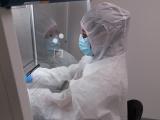Nov 14, 2003 (CIDRAP News) Scientists funded by the US Department of Energy (DOE) created a functioning copy of a virus in the record-breaking time of 2 weeks, DOE officials announced yesterday.
The virus is a phagea type that infects bacteriaand is harmless to humans, officials said. It was created as part of a research program to develop microbes that can help solve energy and environmental problems.
J. Craig Venter, PhD, and colleagues at the Institute for Biological Energy Alternatives (IBEA) in Rockville, Md., synthesized the virus from commercially available pieces of DNA, the DOE said in a news release. "The researchers accomplished this in 14 days, from start to finish, reducing the time required to synthesize such a microbe from many months, even years to days," the department said.
In July 2002, scientists at the State University of New York at Stony Brook announced they had created a synthetic polio virus from commercially available genetic material. That achievement, which reportedly took months, triggered widespread criticism that it could spur bioterrorists to try to create harmful viruses.
Energy Secretary Spencer Abraham, in announcing the creation of the phage, called it "an exciting scientific advance that may speed our ability to develop biology-based solutions for some of our most pressing energy and environmental challenges."
IBEA researchers assembled the virus, called phi X, from "short single strands of synthetically produced, commercially available DNA (known as oligonucleotides) using an adaptation of polymerase chain reaction (PCR), known as polymerase cycle assembly (PCA)," according to an IBEA news release. The virus has 5,386 base pairs. A report of the project will soon be published in the Proceedings of the National Academy of Science, the news release said.
Venter, who is president of the IBEA, chose phi X for several reasons, the institute said. The virus poses no health or ethical concerns, and it was the first organism to be completely sequenced, in 1978. "Finally, its unique genetic code arrangement (overlapping genes) requires very high accuracy, making it easy to verify whether exact synthesis has occurred," the statement said.
The DOE statement cited a goal of eventually creating microbes 100 to 1,000 times larger than the artificial virus. Abraham said, "With this advance, it is easier to imagine, in the not-too-distant future, a colony of specially designed microbes living within the emission-control system of a coal-fired power plant, consuming its pollution and its carbon dioxide, or employing microbes to radically reduce water pollution or to reduce the toxic effects of radioactive waste."
The IBEA is attempting to use biology and genetics to produce biological energy sources and reduce the amount of carbon dioxide released into the atmosphere, the DOE said. In support of that effort, the department gave the IBEA a $3 million grant last year to develop a synthetic genome. Last April DOE announced it would provide another $9 million to the institute over 3 years. IBEA scientists will use the new funds to determine the genetic sequences of all the microbes occurring in a natural microbial community, officials said.
Abraham predicted that future applications of the research will go beyond energy and environmental problems to the development of better vaccines, more disease-resistant crops, and better ways to detect and defeat biological weapons.
A Washington Post report said the IBEA researchers took the small pieces of DNA they obtained commercially and added markers on the ends of each to make them connect in the proper sequence. After the team created the proper laboratory conditions and mixed the pieces together, the fragments assembled themselves into the virus, the report said.
Venter was one of the leaders in the recently completed effort to map the entire human genome and was also a critic of the synthetic polio virus project, the Post report said.


















